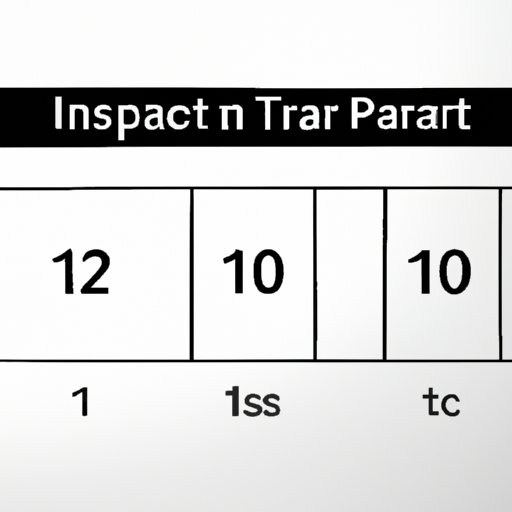I. Introduction
Have you ever wondered why sometimes a video or image doesn’t quite fit the screen? It’s because of the aspect ratio. Aspect ratio is the relationship between the width and height of an image or video. And it’s important because it can affect how the content is displayed and perceived. In this article, we’ll explore what aspect ratio is, the commonly used ratios, how it affects different forms of media, and how to choose the right ratio for your project.
II. Aspect Ratio Demystified: Everything You Need to Know to Get the Perfect Image
Aspect ratio is simply the proportion of an image’s width compared to its height. For example, a square image has an aspect ratio of 1:1, while a widescreen image has an aspect ratio of 16:9. The most common aspect ratios include 1.33:1 (4:3), 1.77:1 (16:9), and 2.35:1 (CinemScope). Each ratio has unique characteristics and uses, with 16:9 being the most common for TV and online video, and 2.35:1 for epic films like Star Wars.
Choosing the right aspect ratio for your project depends on the intended audience and purpose. For example, if you’re creating content for social media, a 1:1 ratio may work best for mobile devices that prefer square images. On the other hand, if you’re creating content for cinematic releases, you may want to choose a wider aspect ratio like 2.35:1 to create a more cinematic feel.

III. Aspect Ratio 101: An Introduction to the Basics of Aspect Ratio and Its Importance in Media
The history of aspect ratio dates back to the early days of cinema. The standard ratio used to be 4:3, which became known as Academy Ratio. However, as widescreen televisions became more popular in the 1950s, aspect ratios began to change to fit the new format. Today, there are many different aspect ratios used in different forms of media, including TV, films, and online videos.
Aspect ratio is important in media because it can affect how the content is displayed and perceived, and can even impact the storytelling. For example, a wider aspect ratio can create a more immersive feel and give the viewer a greater sense of being a part of the story.
IV. The Impact of Aspect Ratio on Film and Television: Why Filmmakers Care About Aspect Ratio and You Should Too
Aspect ratio has a significant impact on storytelling in films and TV shows. For example, a wider aspect ratio can help create a sense of grandeur and epicness, while a narrower ratio can create a more intimate and personal feel. Directors and cinematographers carefully choose the aspect ratio to match the tone and mood they want to convey in their work.
Examples of how aspect ratio is used to enhance the visual experience in films and TV shows include the use of ultra-widescreen aspect ratios like 2.40:1 in epic sagas like Lord of the Rings and the use of multiple aspect ratios in the same film to show changes in time and perspective, as seen in The Grand Budapest Hotel.
Aspect ratio is also important in immersive experiences like virtual reality and augmented reality. The ratio can affect the field of view and how the environment is perceived by the user, making it an essential aspect for the VR and AR developers to consider when creating content for these platforms.
V. The Pros and Cons of Different Aspect Ratios: A Comparison of the Most Common Aspect Ratios Used in Media
Before choosing the right aspect ratio for your project, it’s essential to understand the advantages and disadvantages of each ratio. For example:
- A 1:1 aspect ratio is great for social media because it eliminates the need for cropping, but can feel restrictive for other types of content.
- A 16:9 aspect ratio is widely used for TV and online video, but can feel less cinematic compared to wider ratios.
- A 2.35:1 aspect ratio provides a cinematic feel but may not be suitable for all types of content, especially those intended for smaller screens.
Taking these factors into consideration can help you make the right decision when choosing an aspect ratio for your project. It’s also important to keep in mind that aspect ratio can affect how the content is perceived, so choosing the right ratio can make all the difference in creating a compelling visual experience.
VI. The Science Behind Aspect Ratio: How It Affects the Way We Perceive Images and Videos
Aspect ratio doesn’t just affect the visual appeal of images and videos; it can also affect the way we perceive them. Our brains are wired to perceive images and videos in certain ways, and our emotional response can be influenced by the aspect ratio.
Studies have shown that wider aspect ratios can create a more pleasant and immersive viewing experience, while narrower ratios can produce a more intense emotional response. The right aspect ratio can enhance the mood and tone of your content, and help you create the intended emotional response from your audience.
VII. Aspect Ratio and Its Evolution: From Early Cinema to Modern Day Technology
Aspect ratio has come a long way since the early days of cinema. From the standard Academy Ratio of 4:3 to the ultra-widescreen ratios of modern films, aspect ratio has continued to evolve with new technology and changing audience preferences.
The adaptation of widescreen televisions and the emergence of digital cinema have opened new possibilities for aspect ratios. Aspect ratios can now be easily changed during post-production and have become a crucial part of the creative process for filmmakers and content creators.
As AR and VR technologies continue to evolve, aspect ratio is becoming an even more critical factor in the creative process. The ratio can affect the immersive experience and can make or break the content’s success in this emerging industry.
VIII. Conclusion
Choosing the right aspect ratio is an essential part of creating visually compelling content. Whether it’s for TV, film, the web, or emerging technologies like AR and VR, the aspect ratio can affect how the content is displayed and perceived by the audience. From the history of aspect ratio to the science behind it, this article has explored everything you need to know to make informed decisions about aspect ratios for your projects.
